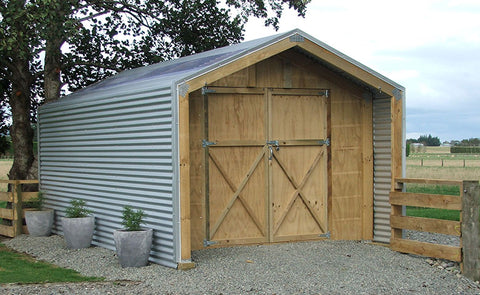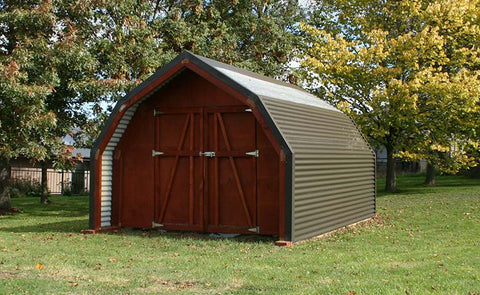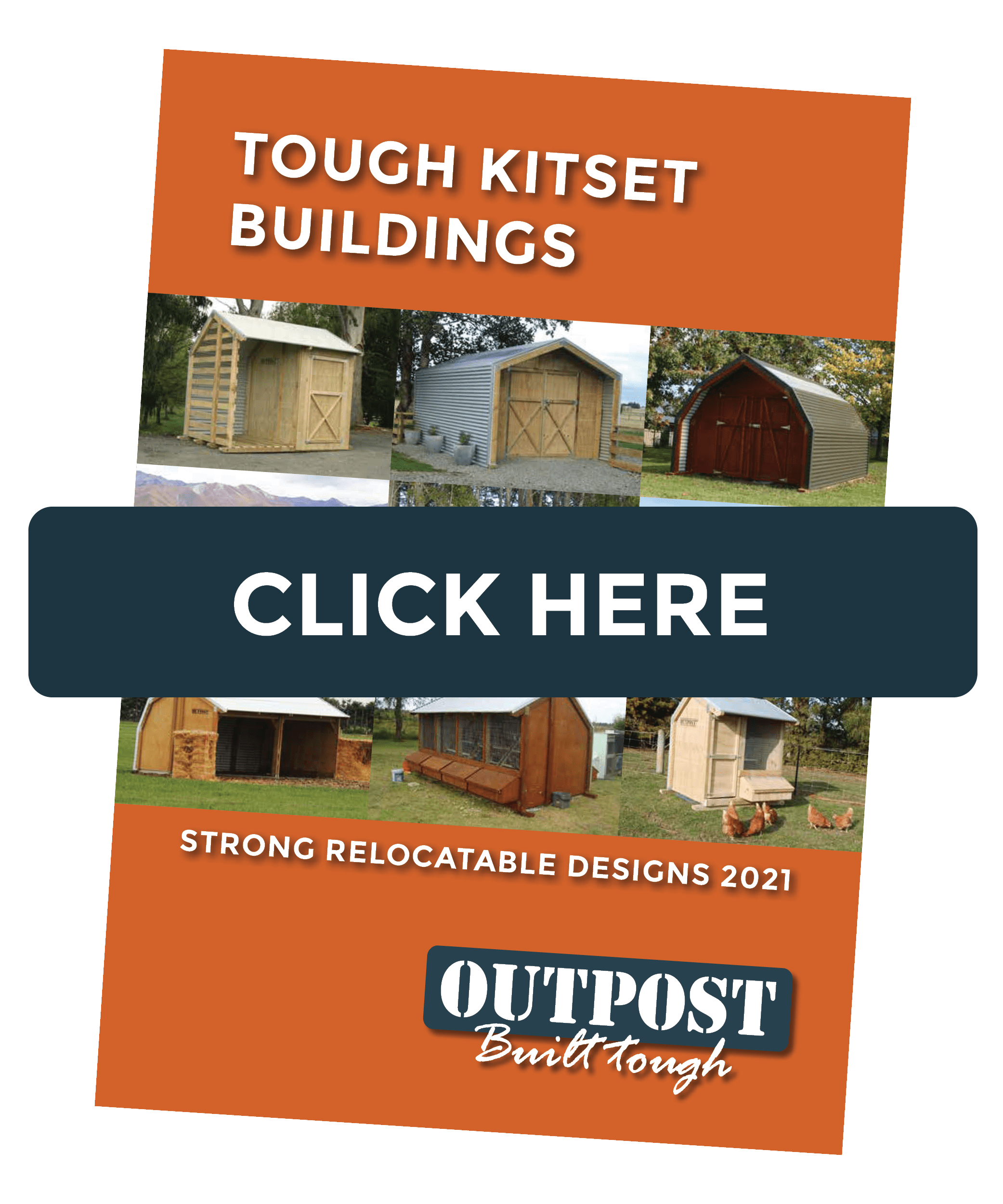If you’re thinking about installing a shed on your property, you’re probably concerned with the size, space, and layout of the structure. But it’s also important to consider the type of material that you choose to construct your shed with.
There are advantages and disadvantages to the type of material you choose for your shed. Metal sheds are durable and low maintenance and have the benefit of being resistant to insects, rot and fire. On the other hand wood sheds can be much stronger, easily customizable and better insulators against the elements.
You might think that we’re just biased but our years of experience in the building industry proves that our built tough wood sheds and shelters will stand the test of time, terrain and temperature.

Is A Metal Shed Better Than A Wooden Shed?
Whether you decide to purchase a metal shed or a wooden shed will depend on what you weigh up to be the most beneficial for you.
Outpost buildings specifically use wood as our material of choice for many reasons. Through our extensive research and rigorous testing, with the right treatment and care we have found wooden sheds to be the sturdiest, most resilient, easiest to customise and best looking. If you take good care of your wooden shed and ensure that the exterior is well painted it will reward you with a lifetime of functionality.
If that’s not enough to convince you, let’s lay out the pros and cons of each material to help you make an informed decision on whether to invest in a wooden shed or a metal one:
Metal Shed
Advantages
- High durability and long lasting
- Easy to assemble
- Low maintenance
- Fire resistant
- Rot resistant
- Insect resistant
Disadvantages
- Susceptible to condensation, rust and corrosion if not treated properly
- Not as sturdy as wood
- Requires an anchored base
- Requires a certain type of paint
- Harder to customise or modify
- Not as visually appealing as wood
Wooden Shed
Advantages
- Easily customisable and versatile
- Environmentally friendly and a renewable resource
- Visually appealing and easy to paint
- Strong and durable
- Can handle high winds
- Traditional shed material
- Better insulator from extreme temperatures
- Easy to add shelves and tool hooks by nailing/screwing into wood
Disadvantages
- Not fire resistant
- Weather resistance (painting) required
- Susceptible to insect infiltration or rot if the wood is untreated
- Maintenance such as painting and cleaning required to keep your shed in top condition

GET A FREE COPY OF OUR CATALOGUE
What Type Of Shed Is Most Durable?
The durability of a shed depends on various factors. Metal as a material is more durable than untreated wood due to wood's susceptibility to insects, rot and moisture. However, if your wooden shed is made with high quality treated timber like Outpost Sheds are then it can prove to be equally as durable as a metal one.
Furthermore, wood is vastly more sturdy than metal in extreme conditions such as high winds and you may find a metal shed will get damaged in high winds if the framing is not very strong..
Outpost wooden sheds are constructed from extra heavy duty, high quality NZ timber framing, and genuine Zincalume or Colorsteel cladding. This guarantees that your shed will stand the test of time against the elements, capable of withstanding any weather conditions that New Zealand can throw at them once they are stained, oiled and painted.
Do Metal Sheds Get Condensation?
A metal shed has many benefits, however there are certain aspects to consider when choosing your shed material. One that can not be overlooked is the possibility of condensation building inside your metal shed. Especially if you’re using your shed to store items that need to stay dry this can become a major issue.
Condensation can occur in your metal shed at night when the air cools down and the interior of the shed is still warm. The warm humid air in the shed rises and comes in contact with the cooler roof surface. This can create condensation on the underside of the shed roof.
To stop condensation occurring in your shed you will need to apply closed-cell polyurethane spray foam to fill every gap and cavity including under the floor. This will allow for moist air to escape before it comes into contact with the cool surface of the shed. You might want to pair this solution with a dehumidifier to ensure condensation stays at bay.
How Do You Insulate A Metal Shed?
Just as the closed-cell polyurethane spray foam can stop your shed from forming condensation it also helps to insulate your metal shed. Metal absorbs the sun's energy very efficiently, and without any insulation amplifies the exterior temperature. Hot days outside become stifling inside your shed and equally as piercing during the colder seasons.
Insulating your shed is not too difficult to do but it can be time consuming and will likely take you a full day. You will need to measure the walls, ceiling and floor area and remove any internal sheathing. Coat all the walls and ceiling with two layers of 2 inch thick spray foam letting it dry in between layers. You will also need to remove the floor to install rigid foam panels between joists or beneath the flooring.
We did the research for you and can take the worry out of insulating a metal shed. Outpost wooden sheds are designed for a wide range of New Zealand conditions, from rain and snow to hail and heat, with cladding and designs made to suit your preferences and needs.
Do Steel Sheds Rust?
Condensation not only wreaks havoc on your shed contents it can also encourage your metal shed to rust. There are things you can do when setting up your metal shed to help prevent rust from the get go.
If you don’t take precautions against rust then your metal shed will succumb to the elements and you won't see it last more than 5 years. If you follow these simple techniques for rust prevention then you’ll get a lot longer out of your shed.
First of all, if you decide to go with a metal shed then you’re going to need a base for it. Laying down gravel or crushed rock beneath your shed is the best and most stable foundation option for metal sheds, this aids draining which can help prevent moisture from collecting around your shed.
Another effective solution to preventing rust is to create sufficient airflow throughout your shed, you can do this with proper storage techniques. Stack all of your stored possessions with space in between them and try to keep everything at least a few inches away from the walls of the shed.
Some steel shed materials are better than others such as galvanised steel. The steel used on Outpost Sheds is genuine Zincalume or Colorsteel which has a very rust resistant coating with great manufacturer guarantees.
Are Wooden Sheds Good?
With all of this in mind, we hope you have come around to our way of thinking. Although purchasing a metal shed might sound appealing in the beginning there are many factors to consider that might hinder the installation, functionality and longevity. For that reason, we will always be more partial to the traditional, resilient and sophisticated wooden equivalent especially with all of the bonuses that come with an Outpost wooden shed kitset.
Outpost Buildings is owned and operated by Kiwis, for Kiwis and every kitset has been designed with the unique conditions of New Zealand rural life. Our materials are sourced from other New Zealand companies as much as we can, making our products as sustainable as possible and made to the highest standards.
How Long Does A Wooden Shed Last?
As with most things we own, the lifespan will last as long as we look after it. Outpost Buildings wood sheds are built tougher and stronger than the average kitset, constructed from extra heavy duty, high quality NZ timber framing, and genuine Zincalume or Colorsteel cladding.
We guarantee the quality of all our materials and you don’t have to just take our word for it. Each kitset comes with a 10-year guarantee. If looked after well, you can easily expect an Outpost wood shed to last more than 20 years.
Our relocatable designs mean that our kitsets can adapt along with you. A hiab truck or trailer can bring your shed with you wherever you move. Or it can be sold on and moved to a new home if you no longer have the need for it.

How Long Does It Take To Put Up A Shed?
Shed installation can be daunting if you’re building it from scratch. That’s why Outpost buildings have full kitsets with everything you need to install your shed, including all the parts precut and ready to assemble, as well as all the well labelled components you will need to secure it in our Hardware Kit.
Some parts of your shed are even partly assembled already such as the doors, gates and framing.
Each Outpost kitset comes with a set of detailed instructions but the time it will take to assemble your shed will depend on the size and how much help you have. With the help of someone with a bit of building experiencer you can have your kitset up within 2-3 days. Outpost buildings come in two classifications:
- Advanced kitsets - good or professional building skills required
- DIY kitsets - basic building skills and tools required
Our advanced kitsets are likely to take a little longer to assemble than our DIY kitsets due to the heavier parts. Here’s a few tips that we put together to help you with the assembling of your kitset.
For additional questions, please contact one the team here at Outpost Buildings.





